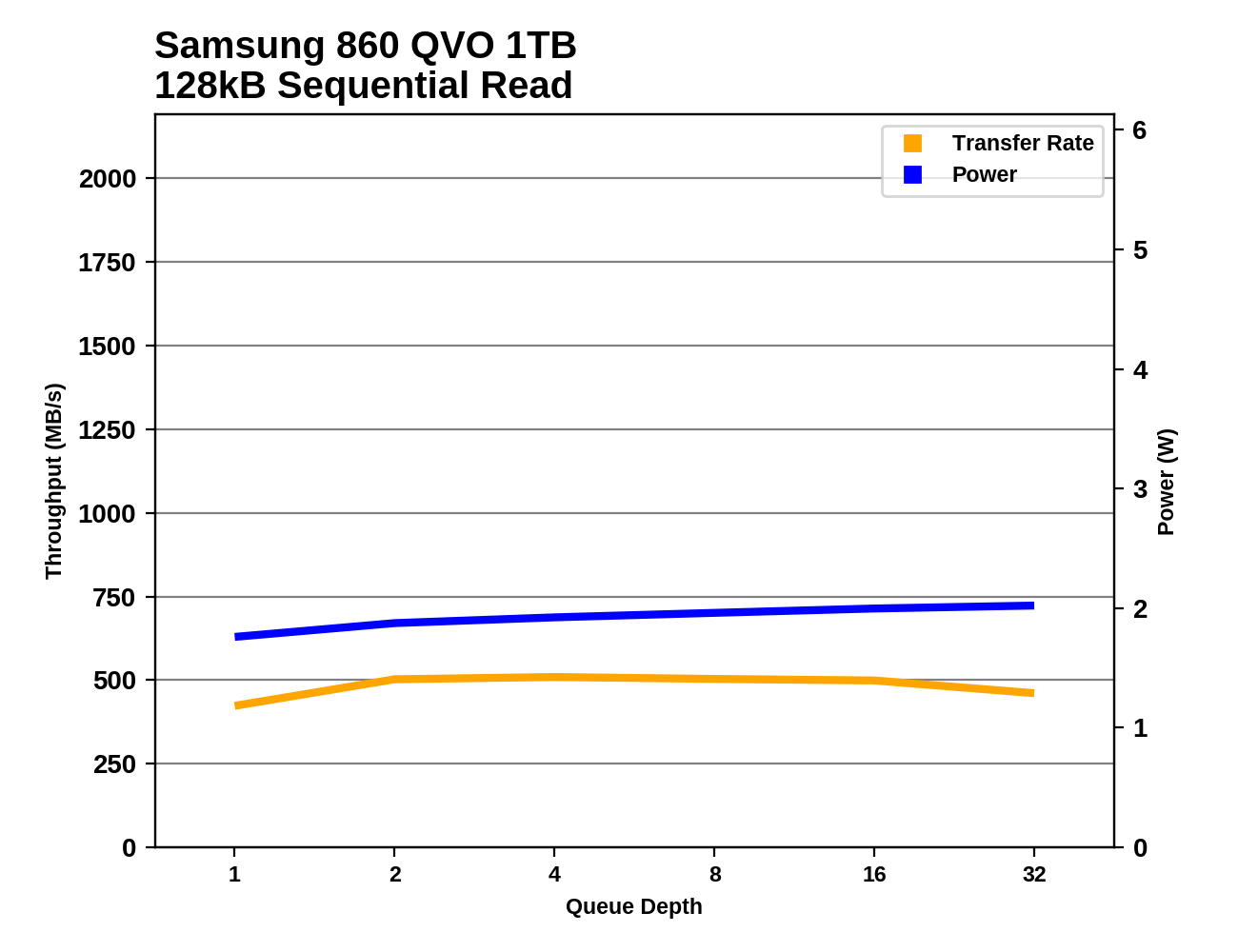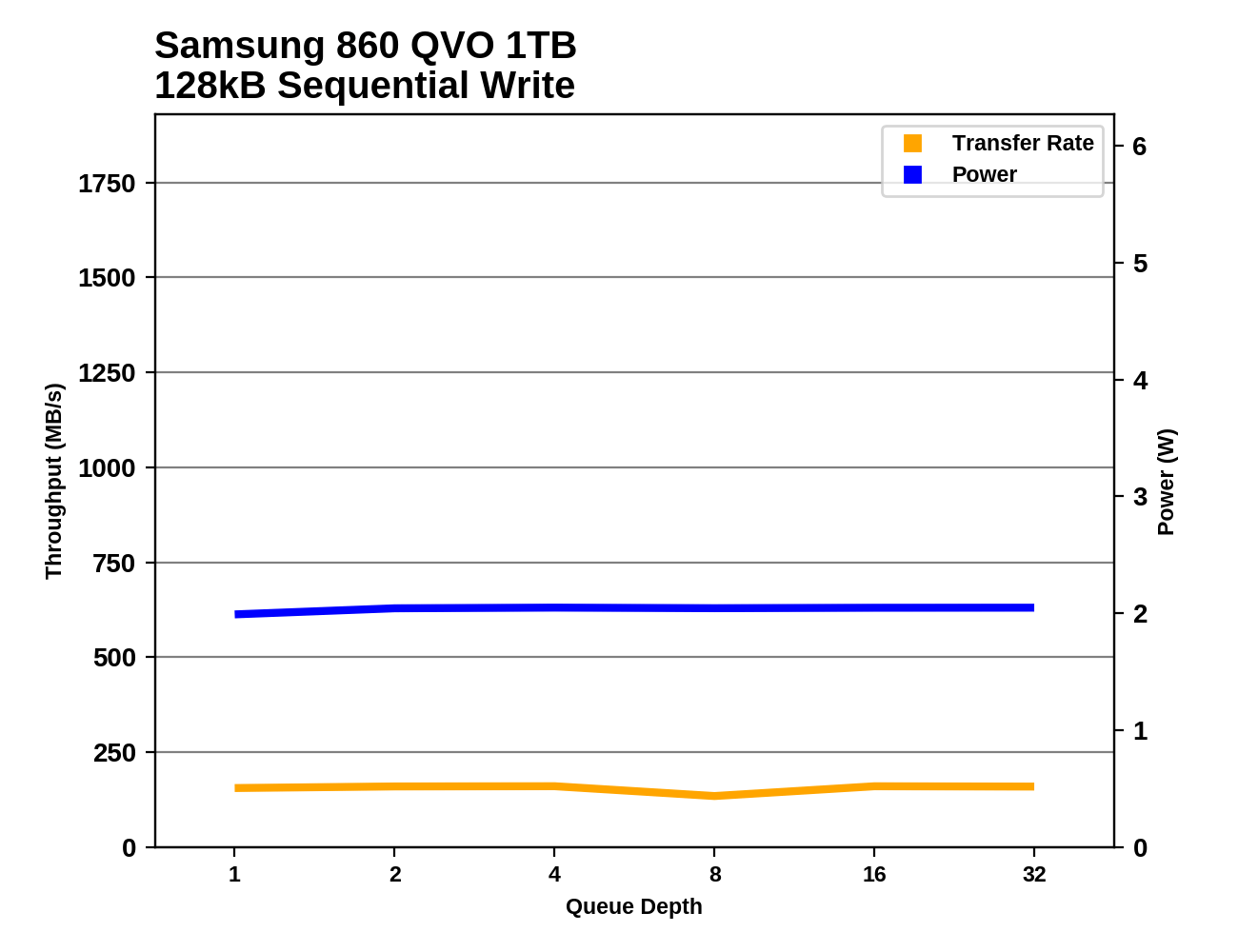The Samsung 860 QVO (1TB, 4TB) SSD Review: First Consumer SATA QLC
by Billy Tallis on November 27, 2018 11:20 AM ESTSequential Read Performance
Our first test of sequential read performance uses short bursts of 128MB, issued as 128kB operations with no queuing. The test averages performance across eight bursts for a total of 1GB of data transferred from a drive containing 16GB of data. Between each burst the drive is given enough idle time to keep the overall duty cycle at 20%.

The burst sequential read performance of the Samsung 860 QVO is generally competitive with mainstream TLC SATA SSDs and is well ahead of the DRAMless Toshiba TR200. The 1TB 860 QVO's score is a bit lower when the drive isn't full because of the timing of the tests: the drive was still flushing the SLC cache in the background when the read test started.
Our test of sustained sequential reads uses queue depths from 1 to 32, with the performance and power scores computed as the average of QD1, QD2 and QD4. Each queue depth is tested for up to one minute or 32GB transferred, from a drive containing 64GB of data. This test is run twice: once with the drive prepared by sequentially writing the test data, and again after the random write test has mixed things up, causing fragmentation inside the SSD that isn't visible to the OS. These two scores represent the two extremes of how the drive would perform under real-world usage, where wear leveling and modifications to some existing data will create some internal fragmentation that degrades performance, but usually not to the extent shown here.

On the longer sequential read test, the 860 QVO continues to get reasonably close to the SATA speed limit when reading data that is contiguous on the flash itself. Where internal fragmentation is caused by writing to the drive randomly, the QVO's read speed suffers much more than for the TLC drives, and the 1TB 860 QVO ends up slightly slower than a mechanical hard drive.
 |
|||||||||
| Power Efficiency in MB/s/W | Average Power in W | ||||||||
The power efficiency of the 860 QVO is only a little bit lower than the TLC drives for the contiguous data case. When dealing with fragmented data, the QVO is slightly more efficient than the Intel/Micron NVMe QLC drives despite being a bit slower.
 |
|||||||||
The queue depth scaling behavior for the 860 QVO is very typical, with QD1 not quite saturating the SATA link but all higher queue depths hitting close to full speed. The one exception is a slight decrease from the 1TB drive during the final QD32 phase.
Aside from the mild QD32 drop in performance, the sequential read behavior of the 860 QVO doesn't fall outside the normal ranges we've come to expect from TLC drives.
Sequential Write Performance
Our test of sequential write burst performance is structured identically to the sequential read burst performance test save for the direction of the data transfer. Each burst writes 128MB as 128kB operations issued at QD1, for a total of 1GB of data written to a drive containing 16GB of data.

The Samsung 860 QVO handles the burst sequential write test fine when the drive is mostly empty and there's plenty of room in the SLC cache. When the drive is full, the 1TB model's speed suffers somewhat, but is still much faster than the mechanical hard drive or the DRAMless TLC drive.
Our test of sustained sequential writes is structured identically to our sustained sequential read test, save for the direction of the data transfers. Queue depths range from 1 to 32 and each queue depth is tested for up to one minute or 32GB, followed by up to one minute of idle time for the drive to cool off and perform garbage collection. The test is confined to a 64GB span of the drive.

On the longer sequential write test, the SLC cache of the 1TB 860 QVO is not quite enough even when the drive is mostly empty, so it ends up in last place. The 4TB model's SLC cache keeps up with this test and it is as fast as any SATA drive.
 |
|||||||||
| Power Efficiency in MB/s/W | Average Power in W | ||||||||
The 860 QVO is a bit more power-hungry than the 860 EVO, so the 4TB QVO only takes third place for efficiency among the SATA drives in this bunch. The 1TB QVO has similar efficiency to the faster but more power-hungry 1TB QLC NVMe drives from Intel and Micron.
 |
|||||||||
The 1TB 860 QVO is mostly slow and steady during the sequential write test, while the 4TB model's performance is as good as any other SATA drive.
The 1TB 860 QVO's sequential write behavior sticks out clearly as far slower than typical, but it's not unprecedented: there have been TLC drives this slow, but most of them were much smaller than 1TB. The 4TB model blends in with the crowd much better.












109 Comments
View All Comments
Lolimaster - Thursday, November 29, 2018 - link
HDD's sweet spot for manufacturers is the 4TB and up, they can't really make them cheaper than $40-50 no matter the size, it got tons of physical moving parts, a big chunk of well crafted aluminum, special sealing, etc vs an SSD that is just nand and a plastic casing before at least you got a thin aluminum case.Glaurung - Tuesday, November 27, 2018 - link
Spinning drives aren't going away - capacities are still going up and spinning drives are still the best deal for extremely high capacity storage - like NAS and datacentre storage. That's unlikely to change any time soon. But the amount of storage that you're realistically going to want inside your computer? It's now affordable to go all SSD for your local internal storage.But storage inside your laptop has until now been a case of needing two drives, a fast SSD to boot off of and a slow HDD for your data. Or else pay a ton for a high capacity SSD, or make do with a small drive
Dr. Swag - Tuesday, November 27, 2018 - link
Selling an inferior SSD to the 860 evo for more! What a great ideaPaoDeTech - Tuesday, November 27, 2018 - link
Lower cost (QLC) higher capacity SSDs are very welcome. Is as simple as that. I read an interesting study that basically concludes that an SSD lifespan is usually limited by age not total writes. Interesting. Can anybody confirm or deny?hojnikb - Tuesday, November 27, 2018 - link
Not really. SSDs don't tend to die of old age or exhausted endurance (not in client workloads anyway) but rather random controller faulires and firmwar bugs.One considuration with such flash is data retention. As these are fairly large drives, they will be used for storage and hence this can become an issue.
PaoDeTech - Tuesday, November 27, 2018 - link
Here's the article: https://www.zdnet.com/article/ssd-reliability-in-t...hojnikb - Wednesday, November 28, 2018 - link
Quickly skimming the article, it does seem to suggest, that age has an effect on raw bit errors. What it doesn't include (not that i can find) is wheter drives were the same model and manufacturer.Older drives could be of inferior controllers and weaker firmware design which can't cope with bit errors as well.
spkay31 - Tuesday, November 27, 2018 - link
Personally I think the Intel 660p NVMe SSD's offer a very nice price performance tradeoff when on sale. Yesterday an Intel 660p 1TB drive was on sale for $130. At around 1800Mbps it's ~ 3.5X faster than a SATA ssd and about 45% cheaper than a Samsung 970 EVO 1TB NVMe drive. OK, so it's 1800Mbps vs 3200Mbps but again for my uses that is certainly excellent speed improvement from a SATA ssd and I'm willing to accept some of the other shortcomings of QLC. My experience is that QLC is already a very reasonable value proposition for many applications.JoeyJoJo123 - Tuesday, November 27, 2018 - link
While I have nothing against the Intel 660p, not QLC, and I very much welcome these technologies, even considering black friday """deals""", I still don't think it has become price competitive (yet).I purchased an 860 EVO 1TB for $127 ($127 after tax/shipping), and then later an MX500 2TB for $209 ($229 after tax/shipping). (Bought the 860 EVO 1TB since the 2TB was $299 and therefore much more expensive in $/GB, and because I hadn't seen anything better by the time it was Saturday, but CyberMonday on Amazon brought the $209 MX500. I may or may not return the 860 EVO.)
Both of these drives are 3D TLC based, and still have their marginal sustained read/write advantages over 3D QLC. Given the (roughly) equivalent price between a 1TB 860 EVO 1TB and Intel 660p 1TB, I don't think it's unfair to say that the 860 EVO should be every customer's pick every single time (again, given these """deal""" prices).
As always, it'll take some time before newer technologies drop in prices and mature in overall value. I'm sure it'll happen for QLC drives, as they did with MLC and TLC before them, but it just hasn't happened quite yet.
Impulses - Thursday, November 29, 2018 - link
Wait what? The 2TB MX500 hit $209 this year? Was it a flash sale or something? I had price alerts set on it, the 860 EVO, and the WD Blue/SanDisk Ultra and the cheapest I saw for a 2TB was $255... Granted I was mostly looking at Amazon, where'd you score that deal?